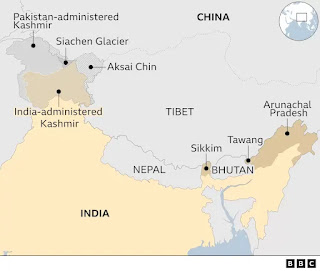On Monday, December, 12, the Indian army said that there had
been a clash with Chinese army in the Tawang, Arunachal Pradesh on December, 9.
Soldiers from both sides injured in clash and no soldiers died or severely
injured in clash. Media reported PLA's soldiers suffered more injuries than the
Indian side. After a clash, both sides immediately disengaged from the area and
commanders from both sides had held a meeting immediately after to restore
peace and tranquility.
India's Defence Minister Rajnath Singh told Parliament that
no Indian soldier was killed or severely injured in the clash.
Defence Minister Rajnath Singh said in Parliament on
December, 14, that the encounter started between Indian and Chinese soldiers,
when Chinese troops tried to encroach into Indian territory and attempted
unilaterally to change the status of quo near Line of Actual Control (LAC) in
Arunachal Pradesh along the disputed border near the Yangtse area.
Mr. Singh said the Indian soldiers befitting replied and
stopped the People’s Liberation Army (PLA) from transgressing into Indian Territory.
Indian Army forced PLA to return to their posts. He said that local military
commanders met on December, 10 to discuss the dispute.
China' reaction
State controlled media Global Times said that there are no
details of the incident and said that according to their knowledge, the
situation on the border with India was generally stable.
The spokesperson of the People’s Liberation Army (PLA),
Western Theater Command said that Chinese border troops were on a routine
patrol on the Chinese side of the Line of Actual Control (LAC) when Indian
troops illegally crossed the line and blocked the Chinese forces.
Chinese Ministry spokesperson Wang Wenbin said while briefing
press that the current situation is “generally stable” and asked India to abide
by the spirit of relevant agreements signed by the two sides.
US reaction
White House press secretary Karine Jean-Pierre said the US is
closely monitoring the situation and encouraging India and China to utilise the
bilateral channels.
Karine Jean-Pierre said, "We are glad to hear that both
sides appeared to have quickly disengaged from the clashes. We are closely
monitoring the situation. We encourage India and China to utilise existing
bilateral channels to discuss disputed boundaries. Again, we are glad to see
that there has been some disengagement on the clashes at this time."
On the other hand, the Pentagon press secretary Patrick
Ryder, while addressing a press conference in US, said that we fully support
India's efforts to control the situation amid the India-China border clash. We
will continue to remain steadfast in our commitment to ensure the security of
our partners. We fully support India's efforts to control the situation.
"Department of Defense continues to watch developments
along the Line of Actual Control (LAC) at India-China border, we have seen
People's Republic of China (PRC) continues to amass forces and build military
infrastructure along so-called LAC," Ryder added.
UN calls for de-escalation
United Nations Secretary-General Antonio Guterres called for
de-escalation on the Indian-China border. "We call for de-escalation and
to ensure that the tensions along in that area do not grow," spokesperson
to UN Secretary-General Antonio Guterres said.
Agreement between India and China of 1996
In recent clash between Indian army and PLA including Galwan
clash in June 2020, No side used any guns.The battle was fought with sticks and
clubs because of 1996 agreement between India and China. Neither side shall use
its military capability against the other side. No armed forces deployed by
either side in the border areas along the Line of Actual Control (LAC) as part
of their respective military strength shall be used to attack the other side,
or engage in military activities that threaten the other side or undermine
peace, tranquility and stability in the India-China border areas.
India-China border dispute
India and China went to war in 1962. China launched an attack
on India on October 20, 1962. India was not prepared for the war and as a
result, around 20,000 Indian soldiers had to clash against the Chinese 80,000
troops. China had occupied most of the parts of Aksai Chin after the conflict
and consolidated its military grip over the area. China rejected all the
attempts by India to settle border dispute peacefully.
Tensions sometimes escalate into skirmishes. However both
sides have been trying to de-escalate since a major clash in June 2020 in the
Galwan Valley in the Ladakh region, where 20 Indian soldiers died. China never
disclosed about Chinese soldier's death. Many reports published more than 40
Chinese soldiers were died in Galwan clash. The battle was fought with sticks
and clubs. No gun was used by either side because of 1996 agreement.
Another face-off in January 2021, troops on both sides
injured. It took place along the border between China and India's Sikkim state.
In September 2021, both countries agreed to disengage from at
a disputed area along a remote western Himalayan border area and both sides
started troop withdrawals.

Blogger Comment
Facebook Comment